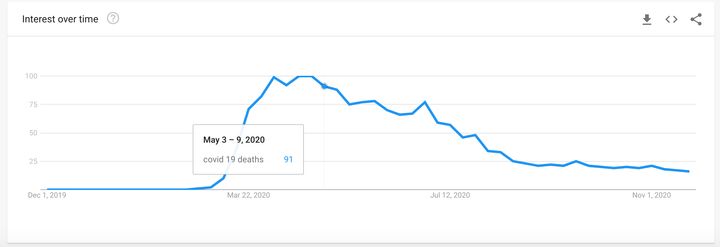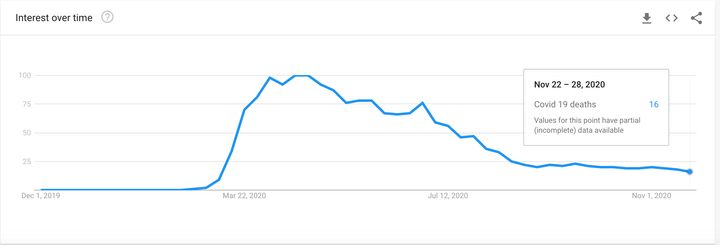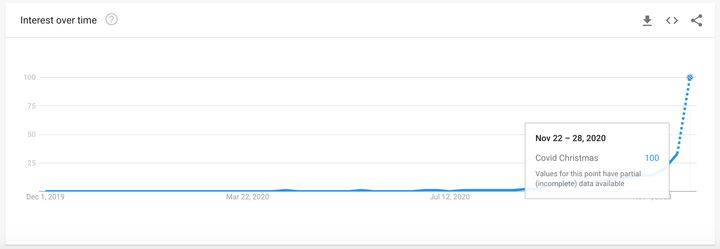With almost 700 Covid deaths recorded on Wednesday and thousands more throughout the week, this looks set to be the UK’s deadliest seven days since early May.
And yet, as Christmas plans and tiered lockdowns dominate the discourse, the daily death tolls have begun to slip out of the government’s discussion of the situation, leaving many frustrated and uncertain about their future plans.
To investigate how the narrative has changed since May, HuffPost UK has compared coverage from this week to that week in May, highlighting how the way we – and those in charge – talk about Covid deaths has changed.
While the figures have since been adjusted, the following death tolls from May have been stated in this article as they were reported at the time.
Monday
May 4, 288 deaths
US university John Hopkins became a leading source of case numbers and the death toll in the first months of the pandemic, and on May 4 it was widely reported that global cases had surpassed 3.5m, with deaths topping 250,000.
Immunity passports, vaccines and a trial of the NHS app on the Isle of Wight dominated the front pages, with the death toll explicitly referred to in the lead story of both The Times and the FT.
In non-UK news, Trump also said he was “very confident” of a vaccine before the end of 2020, and predicted up to 100,000 Covid deaths in the US. Almost 270,000 Americans have now died with the virus.
Meanwhile, optimistic reports about what society could look like after lockdown began to emerge – with staggered office shifts and increased public transport timetables all apparently to be expected.
The UK’s death toll was reported as 288 on May 4, a total which was touted by health secretary Matt Hancock at the time as “lower than at any point since the end of March” during that day’s Downing Street press conference.
He did however state that numbers were artificially lower than they otherwise would be due to reduced reporting over the weekend. This figure has since been revised to 272 by the DHSC.
Hancock announced the death toll within two minutes of the start of the press conference, adding “this is not just a number but it is a constant, insistent reminder that we must go further and faster in our national effort in dealing with this virus.”
November 23, 206 deaths
With the weekend lag in reporting, Monday’s death toll was much lower than the rest of the week – but this time their announcement was barely noticed amid the frenzy around Christmas plans.
Almost every front page anticipated the relaxation of the lockdown post-December 2 ahead of Christmas, with The Times announcing: “PM to ease lockdown with Christmas shopping spree”.
Despite the death toll continuing to climb, the Daily Express lead their front page on Johnson’s five-day festive plan with the line “Christmas is saved”, while The Mirror announced “Xmas gets go-ahead”.
Downing Street no longer holds a daily press conference, but Boris Johnson did appear on Monday evening to confirm the winter plan to return to a tiered lockdown and hint at Christmas plans.
This time around, the PM did not mention the words “death” or “died” once, and the total toll, now well over 55,000 people, was left out of the conference completely.
Tuesday
May 5, 693 deaths
Following a lag in reporting over the weekend, the largest death toll is usually announced on Tuesday. On May 5, the DHSC and media reported this as 693 – though this has now been adjusted to 726.
The UK also became the country with the highest Covid-19 death toll in Europe on the same day, overtaking Italy.
Deaths from Covid topped one national paper, the Daily Mail, which ran the headline “Urgent Probe Into Obesity Link To Covid Deaths”, focusing on an urgent review which had then been launched into the links between obesity, gender and ethnicity and coronavirus fatalities.
Meanwhile, The Independent ran a front page on the potential rollout of an antibody test, The Times concentrated on calls for the public to download the contact tracing app (which would not exist for several more months) and “get [the] UK back to work”, and The Telegraph warned of concerns around the fact that more than six million UK workers were, at that point, furloughed.
Foreign secretary Dominic Raab gave the press conference on May 5, leading again with the daily figures – as was standard during the daily briefings that took place through much of the first wave.
He did not announce the day’s total, instead stating only the cumulative total (29,427 at that point in the pandemic), adding: “Our hearts go out to everyone who has lost a loved one throughout the coronavirus challenge”.
He also did not mention the fact that the UK had the highest death toll in Europe, but that didn’t mean the nation wasn’t talking about it. Thousands of people tweeted about the death toll, or interacted with tweets that referenced it, on May 5.
It was also the day one of the government’s top scientific advisers, Professor Neil Ferguson, resigned after it emerged he had broken lockdown rules despite advocating for social distancing to limit the spread of the virus.
But while Ferguson was widely criticised at the time for breaching the rules he helped create, the real backlash didn’t arrive until news of Dominic Cummings’ trip to Durham emerged several weeks later – a move that went on to actively undermine public confidence in Covid measures.
November 24, 608 deaths
Johnson’s warnings of a harsh winter to come during the press conference led the front pages of several national newspapers on Tuesday, but almost all reference to the climbing death toll was absent from the top stories.
There was no press conference, but many on social media began to question the government’s approach to easing lockdown restrictions as more than 600 deaths were announced on Tuesday afternoon.
Wednesday
May 6, 649 deaths
The fact that the UK now had the highest death toll in Europe made it’s way onto the front pages of just one national newspaper, The Guardian,
Other headlines focused on Professor Ferguson (The Telegraph), while the Financial Times led on Virgin Atlantic axing a third of its workforce.
A quick look at Google Trends reveals that searches for “Covid-19 deaths” remained high around this time, though were gradually starting to drop away in the UK as the nation moved away from the peak of the first wave.

While this figure has since been adjusted to 647, housing minister Robert Jenrick announced 649 deaths during the daily Downing Street press conference.
The cabinet minister described the death toll as “a heart-breaking loss for the loved ones of all those who have died”, but did not comment on the fact that the UK had become the country with the highest death toll in Europe.
November 25, 696 deaths
On Wednesday the UK saw its highest death toll so far during the second wave of Covid-19, with almost 700 deaths.
Despite the previous day also recording the highest number of deaths since May, the front pages on Wednesday largely avoided any mention of the death toll – again fixating on Christmas plans agreed on Tuesday by UK leaders.
Some national papers such as The Guardian did make references to the death toll on their front pages, but apart from The Telegraph – which featured an infographic on cases and deaths on their front page – there were few mentions of the escalating fatalities.
Despite soaring death figures, provisional Google Trends data tells us that searches for the UK death toll have plummeted to a record low.

Meanwhile, searches for Christmas rules have soared as festive plans dominate the conversation.

Thursday
May 7, 539 deaths
On a day where it emerged that a further 539 people had died from Covid-19, it was also revealed that Black people were four times more likely to die of the virus than white people.
The morning papers hailed the arrival of loosening restrictions the following week, with The Sun headlining the lead article “HAPPY MONDAY” and The Telegraph also highlighting the fact that “stay home” advice was to be scrapped.
The FT referred to the UK’s death toll being the highest in Europe in its lead story, while the Metro made perhaps the week’s clearest front page reference to the growing death toll – highlighting that more than 30,000 people had been killed by the virus.
Raab led Thursday’s press conference, which referred to the death toll more than any other briefing throughout the week.
The word “deaths” was used four times, with each of them used within a section of the conference which applauded the government for preventing an even larger number of fatalities.
“I know the tragic death toll in this country and around the world has been sobering for all of us, and there have been real challenges in this country – with PPE, and with care homes,” he admitted.
Seconds later, the foreign secretary added: “We’ve prevented the number of deaths rising to even higher levels, and we’ve ensured critically that the NHS had the capacity to cope.”
November 26, 496 deaths
Despite two days of extremely high death tolls, the PM once again made no reference to fatalities in his statement to parliament on Thursday, during which the PM confirmed that lockdown would end on December 2 – giving way to the three-tier system.
Johnson also avoided mentioning the death toll during his appearance in front of the nation during the Downing Street press briefing later on Thursday afternoon.
The front pages of nation papers were dominated by Rishi Sunak’s spending review, the details of which were announced on Wednesday and included pay freezes for public sector workers and a cut to foreign aid spending.
The Times made no reference to the death toll in its lead story, which was headlined “Covid costs ‘three years of growth to economy’”, while the Daily Express proclaimed: “Rishi’s pledge to deliver on your priorities.”
Replies to official tweets as lockdown tiers were announced on Thursday morning also revealed mounting scepticism to the government’s plans, with conspiracy theories and rejection of the rules dominating the narrative far more than they had done in May.
With the vast majority of England’s population plunged into the toughest lockdown restrictions in tier 2 and 3, even amid cases falling in some areas, concerns about how the government had selected areas to fall under different rules began to dominate the narrative.
Even Tory MPs began to speak out about why they were rejecting their own government’s plans, despite the mounting death toll.
Friday
May 8, 626 deaths
A six-week old baby was among the latest victims of Covid-19, prompting a significant response on social media with hundreds of people replying to tweets from news organisations with condolences – as well as backlash to upcoming plans to loosen lockdown.
May 8 was also VE Day, an occasion the British public were cautiously encouraged to celebrate in a socially distanced manner. So there was a fierce backlash when pictures emerged on social media of people celebrating in other ways.
Friday morning’s front pages largely revolved around lockdowns and VE Day, with The Mirror describing it as a “day of hope” as the Daily Express urged the UK to “keep smiling through”.
Environment secretary George Eustice delivered the daily press briefing, referring to the death toll just once close to the beginning of the broadcast, which was itself mainly focused on VE day and getting food to the most vulnerable people.
November 27, 521 deaths
Friday’s front pages were dominated by frustrations over the tier system.
“Tiers of rage and disbelief” stated the Daily Mail, while The Daily Mirror ran with “tiers of despair”. Neither front page featured details of the death toll.
Despite the death toll increasing by more than 500 for the third time throughout the week, just one national title – The Mirror – published an online article about deaths, however this featured only the totals from the four separate nations as opposed to the DHSC total.
